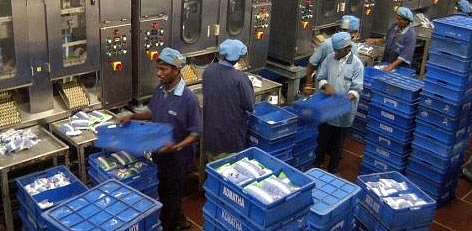Business
Spearheading The White Revolution: The Amma Way
- The story behind the Aavin movement of Tamil Nadu, and the role Jayalalithaa played in it

Workers at an Aavin distribution section
Belonging to a section of society that has never been eligible for government reservation or subsidy, I would normally be against any form of grant, except to the physically handicapped. However, there is one project that doesn’t seem so bad, and in fact, appears beneficial to our economy, and it comes from Amma’s Tamil Nadu – the state’s own white revolution.
Among Amma’s well known schemes are her laptop distribution programme and her chain of Amma Unavagams (canteens that serve food at highly subsidised rates). However, the scheme that I’m highlighting here is where 2,400 milch cows and 10 lakh goats were distributed across the state in 2011 – and taking a step further, they were distributed free.
In two years, 2,000 calves and 2.4 lakh kids had been born to these cows and goats respectively, said a 2013 report. The Tamil Nadu Cooperative Milk Producers’ Federation, operating under the brand name Aavin, even stated that it had begun sourcing close to 80,000 litres of milk from the beneficiaries of this animal distribution programme. The importance of this project came to light in 2014 when then Chief Minister O Panneerselvam announced a milk price hike, which also included an increase of Rs 3 and Rs 4 in the procurement costs of buffalo’s and cow’s milk respectively. Milk producers were getting more money for their milk and it would mean a higher margin for them, since they got the animal for free with fodder and healthcare being the only major expense.
Now, how is this helping the state economy grow?
Let us take a look at Operation Flood (also known as the White Revolution) of the 1970s, spearheaded by Dr Verghese Kurien, who founded Amul and the National Dairy Development Board. It involved taking India from being a milk-deficient nation to being the world’s largest milk producer. In 1998, India surpassed the United States as the largest producer, with producing 17 per cent of the global output in 2011.
How did this happen?
Coming back to Tamil Nadu, the animals were given to milk producers in 2011. The Aavin report of 80,000 litres of milk production came in 2013, which means in two years Aavin saw a sharp increase of 80,000 litres of milk per day from these 2,400 cows and their offspring. In 2015, it was reported that the livestock sector contributed to 4 per cent of the country’s gross domestic product (GDP) with the dairy sector being the largest contributor within it. A thriving, organised dairy sector also improved rural livelihood.
Thus, this subsidy is slowly contributing to an increased milk output in Tamil Nadu alone. While replicating it across the nation is not exactly feasible, there are some benefits that can be put on record.
Rural families are living a better life today with proceeds from milk sales. India is certainly behind nations like Israel and the UK in the average milk yield per cow per day, but this is something that can certainly be fixed. With Aavin buying cow’s milk at Rs 28 per litre and buffalo’s milk at Rs 34 per litre, the milk production of 80,000 litres translates to a huge number. India needs to invest more in researching better quality feed, feed enzymes, cross-breeding of indigenous cow breeds for better output among other things. This will certainly increase the dairy output per day, making rural lives better.
However, the practice of giving away free cows must be gradually stopped and milk producers must be allotted these animals at subsidised rates, or by offering soft loans to them. Today, India exports only a small fraction of its milk output to the world, and this is something that can certainly change, given that it has the world’s largest livestock population.
Support Swarajya's 50 Ground Reports Project & Sponsor A Story
Every general election Swarajya does a 50 ground reports project.
Aimed only at serious readers and those who appreciate the nuances of political undercurrents, the project provides a sense of India's electoral landscape. As you know, these reports are produced after considerable investment of travel, time and effort on the ground.
This time too we've kicked off the project in style and have covered over 30 constituencies already. If you're someone who appreciates such work and have enjoyed our coverage please consider sponsoring a ground report for just Rs 2999 to Rs 19,999 - it goes a long way in helping us produce more quality reportage.
You can also back this project by becoming a subscriber for as little as Rs 999 - so do click on this links and choose a plan that suits you and back us.
Click below to contribute.
Latest